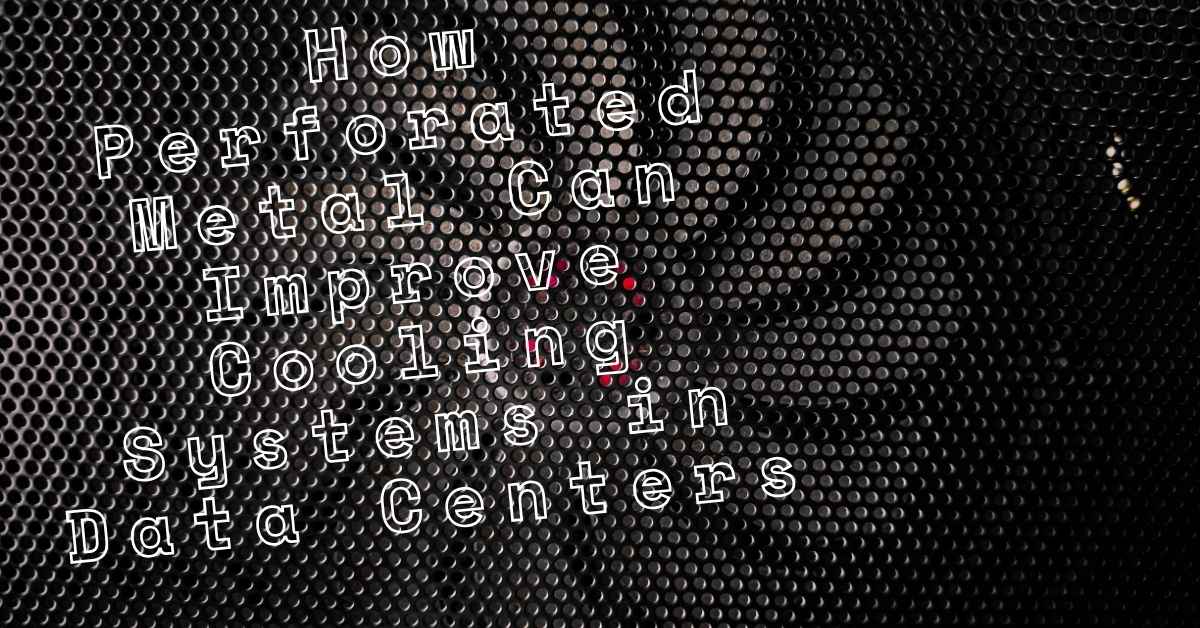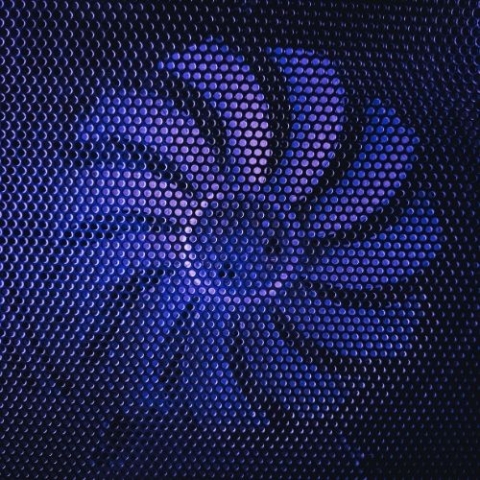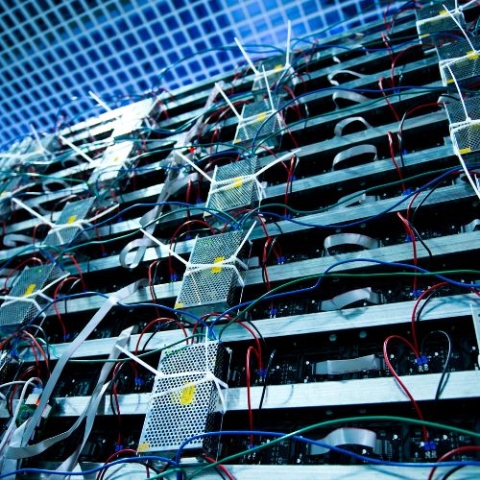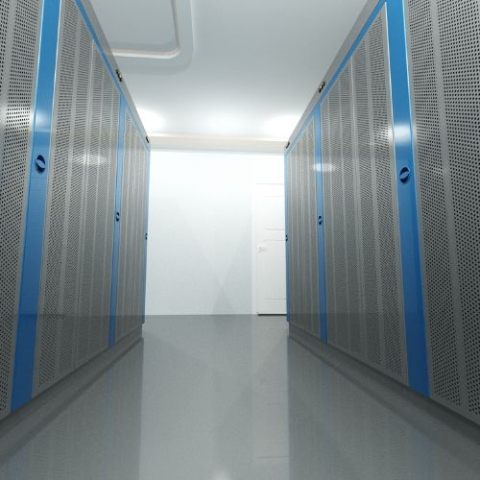
Perforated metal is made from materials such as stainless steel and aluminum that have been mechanically stamped or punched to create a pattern of holes, slots, or other shapes. These perforations serve multiple purposes, including enhancing aesthetics, reducing weight, and facilitating airflow and ventilation. Due to their versatility, perforated metal is utilized across industries, such as facades and sunshades for architectural applications, grilles and filters for automotive applications, and noise control and screening for industrial applications. In data centers, perforated metal panels are crucial in optimizing cooling systems by improving airflow management. This post explores the importance of effective cooling in data centers, the role of perforated metal in airflow management, how perforated metal enhances cooling efficiency, and applications of perforated metal in data centers.
Importance of Effective Cooling in Data Centers
Without proper thermal management, data centers may endure increased energy costs, equipment failures, and reduced performance. Implementing efficient cooling solutions ensures optimal operating conditions, extends the lifespan of hardware, and improves overall system reliability.

- Prevention of Overheating: Excessive heat buildup in data centers can cause system malfunctions and permanent hardware damage, leading to costly repairs or replacements. High temperatures can increase the likelihood of critical failures, resulting in significant downtime and potential data loss. Proper cooling mechanisms, such as airflow management and precision cooling, help maintain safe operating temperatures—cooling strategies like cold aisle containment and liquid cooling further aid in dissipating excess heat efficiently. By preventing overheating, data centers can maintain continuous operations without disruption.
- Energy Efficiency: Cooling systems account for a large portion of a data center's total energy consumption, making efficiency a key factor in reducing operational costs. Advanced cooling technologies, such as free and liquid, optimize temperature control while minimizing power usage. Intelligent airflow management using perforated metal panels enhances cooling distribution, reducing the need for excessive air conditioning. Implementing energy-efficient cooling strategies helps data centers comply with sustainability initiatives and environmental regulations. Lower energy consumption translates to significant cost savings and a reduced carbon footprint.
- Equipment Longevity: Consistently high temperatures accelerate the wear and tear of electronic components, leading to premature failures. Effective cooling solutions help maintain stable temperatures, preventing unnecessary strain on servers, storage devices, and networking equipment. By minimizing thermal stress, data center operators can extend the lifespan of their IT assets, reducing the frequency of hardware replacements. Maintaining optimal cooling also decreases maintenance costs by preventing issues related to overheating and electrical failures. Proper airflow management, including perforated metal enclosures, ensures long-term hardware reliability.
- Performance Optimization: When exposed to excessive heat, processors and other critical components may throttle their performance to prevent overheating, causing system slowdowns. Efficient cooling strategies ensure that servers can operate at their maximum performance levels without the risk of thermal throttling. Proper airflow distribution eliminates hotspots, allowing consistent temperature management across all racks and equipment. Reduced cooling-related bottlenecks improve data processing speeds, optimizing the overall performance of IT systems. Keeping temperatures within recommended thresholds helps maintain efficiency in high-performance computing environments.
- Regulatory Compliance: Data centers must adhere to strict industry standards to ensure safe and efficient operations. Compliance with these regulations necessitates implementing effective cooling measures that meet temperature and energy efficiency benchmarks. Failure to maintain proper cooling conditions can result in penalties, increased insurance costs, or loss of certifications. Many organizations aim to achieve sustainability goals by adopting energy-efficient cooling solutions that align with environmental regulations. Ensuring compliance enhances reliability and improves the data center's reputation and credibility.
Role of Perforated Metal Panels in Airflow Management

Perforated metal panels help maintain optimal airflow in data centers by ensuring that cool air reaches equipment efficiently while warm air is adequately expelled. These panels are strategically placed in various parts of the infrastructure to regulate airflow, improve cooling efficiency, and maintain stable environmental conditions. Their design and customization allow data centers to optimize ventilation, reduce energy consumption, and enhance equipment longevity.
- Enhanced Air Distribution: Perforated panels in raised floors enable the controlled distribution of cool air, ensuring that it reaches critical areas where servers and other hardware generate heat. By directing airflow precisely, these panels help maintain consistent temperatures across sections, preventing localized overheating. This targeted approach reduces cooling inefficiencies and eliminates hotspots, which can lead to equipment failures and performance issues. Additionally, improved air distribution enhances the overall effectiveness of cooling strategies, supporting the stable operation of critical IT infrastructure.
- Pressure Regulation: Perforated metal panels are designed with specific hole patterns that regulate the amount of air passing through, maintaining balanced pressure levels within the cooling system. Proper pressure regulation ensures cooling units operate efficiently, preventing unnecessary strain on HVAC systems. When airflow resistance is optimized, cool air moves effectively through the data center without excessive turbulence, reducing energy waste. Maintaining consistent air pressure also ensures that warm air is effectively exhausted, preventing heat buildup in enclosed spaces.
- Integration in Infrastructure: Perforated metal panels are widely incorporated into raised floor systems, ceiling panels, and server cabinets to support ventilation and optimize cooling. Raised floor tiles with perforations enable air circulation from underfloor cooling units, directing airflow precisely where needed. Ceiling panels with perforated designs allow warm air to exit efficiently, preventing it from being trapped and increasing cooling efficiency. Additionally, server cabinet doors and side panels with perforations promote airflow through racks, reducing thermal buildup inside enclosures.
- Customization: Perforated metal panels can be manufactured with different hole sizes, shapes, and patterns to meet a data center's specific airflow demands. Customization allows airflow to be directed based on the cooling system's requirements, improving efficiency without compromising structural integrity. By tailoring perforation designs, data centers can balance ventilation with security, ensuring that cooling performance is optimized while maintaining equipment protection. This flexibility makes perforated metal a versatile solution that can adapt to varying cooling strategies and layouts.
- Structural Support: Beyond airflow management, perforated metal panels contribute to the structural stability of flooring systems, racks, and enclosures. Raised floor panels with perforations are strong enough to support heavy server racks and equipment while maintaining adequate ventilation. Server enclosures benefit from perforated panels that provide security while allowing heat dissipation, reducing the risk of overheating. Additionally, these panels are made from durable materials like steel and aluminum, ensuring long-term performance and resistance to wear in high-traffic environments.
Applications of Perforated Metal in Data Centers

Perforated metal panels find diverse applications in data centers, each contributing to improved cooling and operational efficiency.
- Raised Floor Systems: Perforated metal floor tiles are strategically placed in raised flooring to regulate airflow, allowing cool air from underfloor plenums to reach critical IT equipment and maintain temperature stability.
- Server Rack Doors and Panels: Perforated metal is integrated into server rack doors and side panels to optimize airflow, prevent hotspots, and ensure consistent cooling for high-performance servers.
- Ceiling Panels: Specialized perforated ceiling panels contribute to effective return air management, channeling warm exhaust air back to cooling systems for energy-efficient climate control.
- Security Enclosures: Robust perforated metal enclosures offer physical protection for data center equipment while allowing adequate ventilation to prevent overheating and maintain airflow efficiency.
- Cable Management Trays: Perforated cable trays support structured cabling systems by promoting air circulation, reducing thermal accumulation, and ensuring organized cable routing for seamless operations.
How Perforated Metal Ca Improve Cooling Systems In Data Centers
The strategic use of perforated metal panels in data center design significantly enhances cooling efficiency through improved airflow dynamics and thermal management.
- Targeted Cooling: Perforated floor tiles enable precise air distribution by directing cool air exactly where needed, typically at the server intake. This reduces air mixing, preventing hot spots and ensuring more effective temperature control.
- Energy Savings: Perforated panels allow optimized airflow circulation, reducing the strain on cooling systems and minimizing unnecessary energy consumption. This leads to lower operational costs and a more energy-efficient data center environment.
- Scalability: As the number of servers and heat output increase, perforated metal solutions can be modified or expanded without requiring significant structural changes. This flexibility supports growing IT infrastructure while maintaining cooling efficiency.
- Compatibility with Containment Strategies: Perforated metal panels align with hot and cold aisle containment methods by controlling airflow direction. This prevents unwanted mixing of hot and cold air, making cooling systems more effective and reducing energy waste.
- Durability and Maintenance: Perforated metal panels are designed for long-term use. They are strong, corrosion-resistant, and require minimal upkeep. Their sturdy construction ensures continuous airflow management without frequent replacements or high maintenance costs.
Ensure Optimal Cooling for Your Data Center with Accurate Perforating
Are you worried about overheating in your data center? Accurate Perforating provides high-quality perforated metal solutions designed to optimize airflow, reduce heat accumulation, and enhance cooling performance. Our durable, reliable materials ensure your systems run smoothly and efficiently. Do you have specific requirements or questions? Contact our sales team today to discuss your data center's needs.